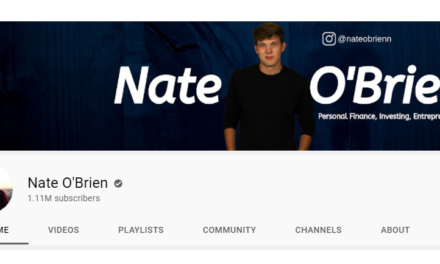We all know that good word-of-mouth is integral to the success of a business. I bet the last time you tried out a new restaurant, you did it on the recommendation of a friend—or maybe you just checked the Yelp reviews. The 2015 “Nielsen Global Trust in Advertising” report found that 83% of “online respondents in 60 countries say they trust the recommendations of friends and family.” Whether you do it in real life or on the web, you are turning to other people to help make decisions—and this is the basis of influencer marketing.
TapInfluence defines the burgeoning industry this way: “Influencer marketing is a type of marketing that focuses on using key leaders to drive your brand’s message to the larger market. Rather than marketing directly to a large group of consumers, you instead inspire/hire/pay influencers to get out the word for you.” This technique is surging in popularity. Although it’s always been a natural companion for social media, visual networks such Pinterest and Instagram have been especially integral to the growth of influencer marketing.
According to Maria Sipka, co-founder and chief evangelist of Linqia, “only 1% of Millennials trust the content that brands create.” Meanwhile, marketers are distressed by the fraud and ad blocking that plague traditional display ads. Sipka adds, “With all of that in mind, brands are really turning to influencer marketing … reaching them in a way that’s more nuanced.”
“The State of Influencer Marketing 2017,” from Linqia, found that 86% of survey respondents had employed influencer marketing in 2016. Of those respondents, 94% say they found it to be effective. And marketers found authentic content to be the biggest benefit. So if you aren’t already relying on influencer marketing as part of your overall strategy, it might be time to start.
In many ways, much of the work of an influencer campaign falls on the shoulders of the influencer—the one actually creating the content—but that doesn’t mean there isn’t work to be done on the brand’s end. “A lot of the consideration needs to be had before a brand jumps into the deep end,” says Sipka.
Here are five steps to make sure your influencer marketing is a success.
Step 1: Identify Your Goals and How to Measure Success
You may find that launching an influencer campaign has a lot in common with your other marketing endeavors—especially the starting point. Before you can implement your campaign, you need to identify your goals and how you’ll measure success. Are you hoping to build customer loyalty, or are you interested in building up your email subscriber database? Before you do anything else, you need to figure out the answer to those questions.
In the case of influencer marketing, you may decide you have secondary goals. For instance, Sipka says, you should be asking yourself, “What are some of the other results the brand is looking for? Do we want to leverage the content? Do we want to deepen our search imprint in Pinterest or Google?” This is how you will decide how to leverage all of that value that’s delivered by influencers and make your investment last longer.
There are also some smaller details you’ll need to suss out, says Sipka. Gorka Muñecas, kasitoko’s CEO and founder, agrees. Are you promoting a particular product or your whole company? What are the pertinent dates to your campaign? What is your budget? And, of course, what stories do you want to tell?
Step 2: Find a Partner (or Not)
Once you have the basics in place, you’ll need to decide if you want to work with an agency or go directly to the influencers. How do you figure out which strategy is right for you?
If you’re working in a small niche where there are only a handful of influencers, it may make sense to go straight to those influencers. But brands operating in larger spheres are likely going to need help. Sipka suggests doing your research and figuring out which companies or agencies are working with influencers in your industry or helping create content for similar brands.
Trying to go it alone can be time-consuming. Sipka says manually managing influencers can take about 2 hours per influencer. “If you want to do this at scale beyond 10 or 20 influencers, you’ll have to have someone do it full time,” she adds.
You will want to reach out to a few possible partners until you find the one that’s right for you. And be sure to consider the payment model. Are you paying per post or for performance? “Once you’ve determined an influencer partner, you need a contract,” says Sipka. Then you will move on to a kickoff call, with which you’ll take the next steps in your journey.
Step 3: Define Your Strategy
“The success of the program is only as good as the story that’s being told,” says Sipka, and that’s why defining your strategy just may be the most important step on the road to influencer marketing success. During this step, consider three main issues:
- What story do you want to tell?
- What content types do you want to employ?
- What audience do you want to reach?
Figuring out the answers to these questions requires you to understand what business objectives you’re trying to address—which, hopefully, you thought about in the first step. “The brief is really important. Influencers must have all the information about the advertiser and what they want to promote,” says Muñecas.
You will also need to determine what kind of influencer you want to use—a celebrity or a subject matter expert. Sipka says Linqia focuses on “power middle influencers”—who have an average of about 30,000 followers. Depending on your product and your goals, you may decide to go with more expensive top-tier celebrity influencers or micro-influencers.
Step 4: Launch
The influencers will take it from here. All you have to do is sit back and hope that the work you did in the first three steps will result in the content and exposure you wanted.
Step 5: Analyze
“When the campaign is published, you should analyze the results in real time,” says Muñecas. “After launching, a campaign starts the most important process. Brands need an exhaustive report to know exactly who … they reach and the engagement that they get from them.”
Sipka says the industry is moving away from “vanity metrics” and looking to more telling numbers. First, she says you want to make sure you’re reaching the right audience, but after that, you want to look for engagement metrics. (For instance, are people liking, sharing, and commenting on the content?) Last, but not least, determine whether the content is driving customers back to your site to do things such as download a coupon or sign up for emails.
Once you’ve determined where your campaign succeeded—and maybe failed—it’s time to adjust and repeat. “It’s all about the end result—it’s not necessarily about the cheapest solution,” says Sipka. In the end, you may need to adjust your strategy or change partners, but we suspect you’ll see enough success to try again.






